Intel X58 Motherboard Roundup - What does $300 Get You?
by Gary Key on December 5, 2008 3:00 PM EST- Posted in
- Motherboards
Gigabyte GA-EX58-UD5
Features
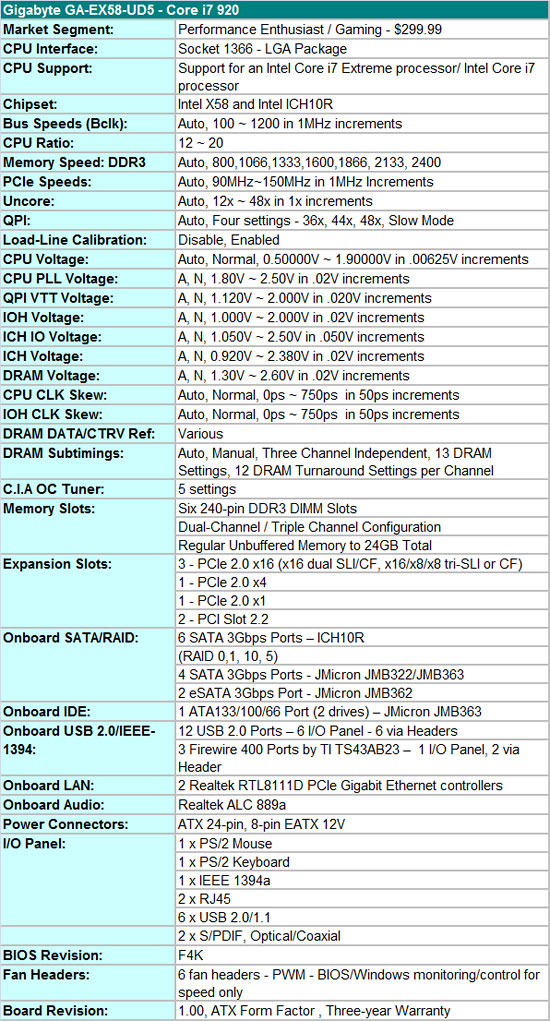
We have to hand it to Gigabyte; if there was an empty spot on the board during the design phase, they figured out a way to add a feature in that space. This board is loaded with everything but the kitchen sink and yet it appears mostly uncluttered; only when using the board do you sometimes notice that it is crowded. Gigabyte throws in twin Realtek RTL-8111D PCIe Gigabit Ethernet controllers that can be teamed; the Realtek ALC-889a is on board for HD audio and features real-time Dolby Digital Live encoding; JMicron’s JMB322/363 chipsets are tabbed for IDE and additional SATA port duties; TI is selected for IEEE 1394a; and the Intel ICH10R is onboard for primary storage purposes.
The BIOS is designed for those who like to tweak for a living. For some, the number of available options will be overwhelming while others will take joy in squeezing out every last little bit the board has to offer. The number of memory timing options is immense and includes the ability to setting timings for each individual channel. However, as we also found with the ASUS board, the auto settings are not always spot on.
Also, the latest beta BIOS we utilized (F4H) has a habit of overriding manual memory settings. This can be a good and bad decision on behalf of the BIOS. The good is that it will do its best to keep the user out of trouble; the bad is that when we manually tweak a board we would like to know when we are in trouble. In the end, the settings determined by the BIOS were always stable and performance was generally not detrimental. We will look at this as a glass half full situation. (update - BIOS F4K received today corrects this problem)
The only nitpick we truly have with the BIOS centers on Load-Line calibration. The purpose of this setting is to reduce VDroop and it works perfectly on the other boards. On our particular board sample we still noticed VDroop when a VCore setting of 1.425V resulted in 1.392V real. Gigabyte is aware of this and is working on it now. Otherwise, we commend Gigabyte for a well laid out BIOS and for offering the enthusiast just about every option one could use on a board.
Gigabyte supports a stock 800MHz ~ 2400MHz memory speed on the i920/i940 processors along with opening up QPI link speeds from a standard 4.800 GT/s up to 6.400 GT/s. They also include a slow mode QPI link speed for high Bclk testing. The board supports up to 24GB of DDR3 memory. We have not had any problems running 12GB of our Patriot or G.Skill DDR3-1600 kits with the latest F4H BIOS. Our final settings are at 1600 with 9-9-9-24 1T timings at 1.66V. Although the timings are looser than the other boards, performance is basically equal; only a user looking for that last bit of advantage in a benchmark would notice a difference.
The three PCI Express 2.0 x16 slots will operate in x16/x16 mode for 2x SLI/CF if the third x16 slot is empty. If you decide to place a PCIe RAID, network, audio, or TV tuner card in the third x16 slot, then the 2x SLI/CF configuration will operate in x16/x8 mode. 3x SLI/CF configurations will run in x16/x8/x8 mode. We had no problems running our ASUS Xonar D2X or Highpoint Rocket RAID cards in x16 slots two or three.
The Board
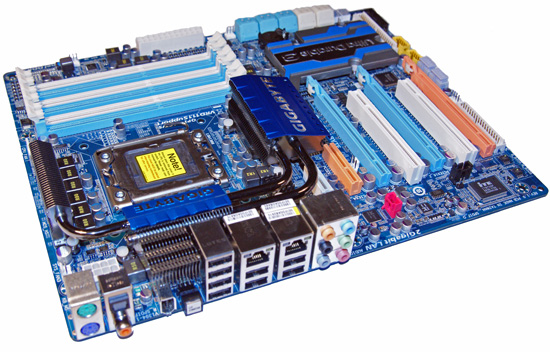
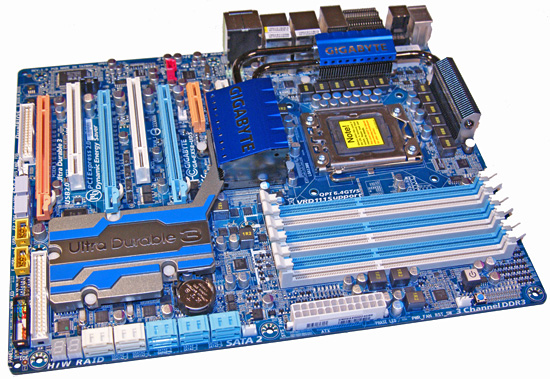
The $299 GA-EX58-UD5 is Gigabyte's mid-range X58 board, with the Extreme version being at the top end with a $330 price tag and the DS4 board placed at the low end with a $245 street price. We think Gigabyte's product separation is right on considering the feature set on each board, although we had hoped the DS4 would also have SLI capability considering the additional cost when compared to the MSI Platinum board.
Gigabyte introduced a new color palette on this board and we like it for the most part. We still notice a few of the crayola colors in use but overall this board would not look bad in a case with a large window. The one item that stands out on the board is the rather large heatsink for the ICH10R/JMicron controllers proudly displaying the Ultra Durable 3 technology incorporated on the board. Ultra Durable 3 refers to Gigabyte's use of solid-state Japanese capacitors, ferrite core chokes, and low RDS(on) MOSFETs along with an extra dose of copper in the board layers.
All of this is meant to improve overclocking potential and extend the life of the board. Until we get to our sub-zero overclocking article, it has been difficult to notice any overclocking differences between this board and the others in our roundup. However, we do appreciate the high quality components that Gigabyte included at this price point.
Gigabyte provides a hefty combination of heatsinks for the northbridge and vrm areas that link together with a heatpipe system. In fact, part of the first VRM heatsink extends into the IO panel to provide an exhaust outlet for the cooling system. Of course this system relies on radial type cooling for proper heat dispersion. We highly recommend direct air-cooling in this area if you are utilizing a tower heatsink/fan for the CPU or water-cooling when overclocking.
The CPU area is fairly open and our larger air coolers installed perfectly without interference from the heatsinks. However, a large air cooler like the Monsoon Vigor III that we utilized will render the first DIMM socket unusable, essentially limiting you to only populating three of the DIMM slots. This board features a two-phase power delivery system for the northbridge and a two-phase delivery for the memory subsystem. A twelve-phase power delivery design is utilized for the processor, which could be construed as overkill, but it does serve its purpose when overclocking. Like the other boards, the capacitors in the CPU area are fairly close to the 1366 socket, something that is important to note when utilizing other cooling methods like large water blocks, cascade, or LN2 setups.
The general layout is very good considering the vast number of ports, slots, and hardware included on the board. Gigabyte's design keeps interference to a minimum with installed peripherals for the most part. The board includes three PCI Express 2.0 x16 slots (x16/x8/x8), one PCIe x1 slot, a single x4 slot, and two PCI slots. This arrangement allows 3X Crossfire or SLI and still leaves the PCIe x1 and x4 slots open. However, using double slot cards for CF or SLI will render the PCI slots physically unusable. It is at this point that we realized a couple of potential problems with this layout.
The first PCIe x1 slot can only be utilized with a half length card, which excludes most audio and tuner cards. The bigger problem is that when utilizing two double slot cards for CF or SLI, the cards sit right next to each other, which inhibits airflow. The same holds true when utilizing the third x16 slot. When installing a dual-slot card in the third slot, it will hangover the board, which could create an installation problem in most cases. We do not care for 3X CF/SLI for general gaming, so we would have preferred a proper dual x16 design or an additional slot between the first two x16 slots to improve cooling or allow water-cooling on the GPUs.
At the rear of the board are the ten SATA ports, a Debug LED display unit, and the IDE connector. The gigantic heatsink covers the ICH10R and the JMB 363/322 controller chipsets. The JMB322s are responsible for the two white SATA ports and offer driver-free RAID 0 and 1 support. The hardware stack in the JMB322 makes arrays appear as standard hard drives and hence the lack of required software drivers when setting them up. Gigabyte took a different approach and hooked the JMB322s directly into JMB363 SATA ports instead of riding on the PCI Express bus as they do on the MSI board. This results in slightly lower performance as our PCMark Vantage HDD test suite will indicate later on. All ten SATA ports have a right angle cable connection scheme that allows them to be utilized even with the longer double-slot video cards. About the only drawback is placing this board in a smaller case where the drive bays would butt up against the board. Even so, we feel this arrangement is the right way to go.
In a change from other board designs, Gigabyte locates the power on and reset buttons behind the DIMM slots, an unusual location but one that we grew accustomed to quickly. At the front of the board Gigabyte places their dual BIOS chips, which can come in handy in case a flash attempt goes south. Also, they figured out a way to include a floppy connector, although we no longer care to see them on boards in this market sector. Gigabyte also throws in some onboard LEDs to light up your life. Actually, they do serve a purpose besides looking cool in a windowed case at night: the LEDs will let you know how many phases are being utilized by the board during operation.
The IO panel features eight USB 2.0 ports, two Ethernet jacks with LED indicators, an IEEE 1394a port, standard PS/2 keyboard/mouse ports, coaxial and optical S/PDIF output ports, and a handy clear CMOS button. The audio panel offers connections to the Realtek ALC 889a HD audio codec. The one thing missing on this board is a fixed eSATA port. However, Gigabyte includes an expansion slot backplate that allows an additional two external SATA ports via any of the board's internal SATA connections.
The Applications
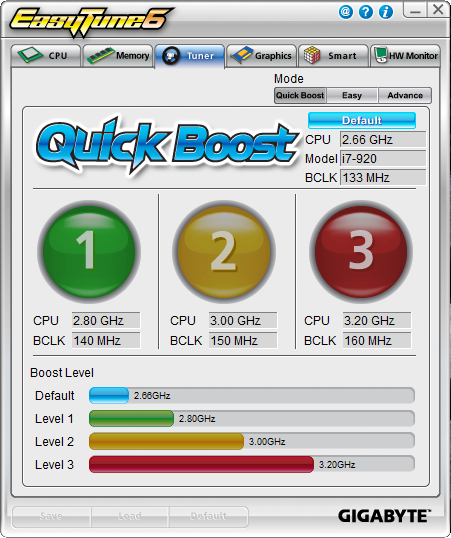
Gigabyte provides their EasyTune 6 application that provides monitoring, system information, and overclocking capabilities. This is one of the best applications provided by the various motherboard suppliers for tuning the system within Windows. We would still like to see the ability to save the settings to the BIOS or at least a BIOS profile; otherwise, this application is useful for extracting a fair amount of performance improvement out of the system within Windows.
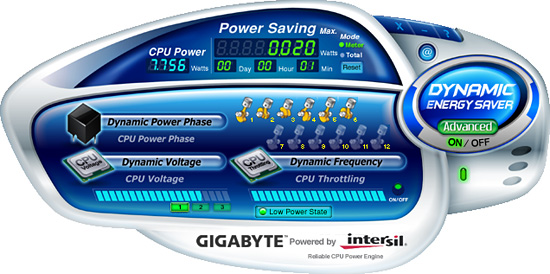
Gigabyte recently updated their DES (Dynamic Energy Saver) software so it is compatible with the X58 chipset, along with providing BIOS improvements. Our original F2 BIOS would not work properly with the latest DES beta but the F4 series has made great strides in this department. We noticed a 5W improvement in idle rates and a 1W improvement in our load tests with DES. Gigabyte expects some additional savings once the software and BIOS are finalized. The DES system offered fast switching times once a full load was placed on the system and we did not experience any crashes during our benchmark tests.






















78 Comments
View All Comments
Zak - Saturday, December 6, 2008 - link
I still had working PII and PIII mobos that I trashed this year, not because they were bad but because these platforms were outdated. These mobos still worked 100% after what 7-8 years??? Each mobo I bough within the last 3-4 years never lasted more than 2 years without some major malfunction (some controller dying, memory slots failing, etc). The boards are getting more expensive and less reliable. There is an obsession with overclocking without any effort to offer perfect stability. Most users want a good balance of speed and stability, and as we all know one isn't any good without the other. Besides, overclocking yields minimal real life gains, unless you do something really extreme, and how many people do extreme overclocking??? Mobo makers should focus on stability and features first. Eh...We live in beta culture:(Z.
Griswold - Saturday, December 6, 2008 - link
What does AT get for being a quasi outsourced QA branch of these mobo manufacturers? To me it looks like you're being taken advantage of - its great that you work with them to get stuff fixed, but is there any compensation for the time invested other than the good feeling?Syntience - Saturday, December 6, 2008 - link
Some of us have non-parallelizable applications (in our case, a certain kind of AI research) that require vast amounts of memory but don't require that much in the way of processing power. We buy the motherboards with the highest number of memory slots and fill those up with the largest memory modules we can reasonably afford. At the moment (late 2008) that means 4GB DDR2 modules. Boards like SuperMicro H8QMi-2+ have 32 DIMM sockets on the motherboard which means our current sweet spot is 128GB.We expect motherboards to operate in these fully loaded configurations, and so far we've been quite lucky. But we'd appreciate manufacturers and reviewers consistently testing boards in whatever max memory capacity the manufacturer is advertising.
Incidentally, we'd like to see motherboard manufacturers produce systems with DIMM sockets on daughter boards that could be stacked to some depth for even more memory, or even return to backplane/bus based designs with multiple separate memory boards. I don't know whether this is economically feasible to do with current memory interface chip sets. It clearly is possible, since these kinds of systems are available in the turnkey server market.
- Monica
LTG - Saturday, December 6, 2008 - link
What you guys are doing is outstanding and exactly the right thing.What's the saying, sunshine is the best disinfectant?
That's what manufacturers need - as much light as possible shown on their quality and stability issues.
Let the best companies reap the rewards just as the top automakers do with their reliability measures.
DaveLessnau - Saturday, December 6, 2008 - link
The reason manufacturers have thrown reliability, stability, and maintainability (i.e., Quality) out the window is because of the way the review sites review their products. Back in the day, places like PC Magazine would do yearly articles that talked about which manufacturer produced, essentially, the highest quality products. Try to find something like that today. If a board doesn't have glowing fins, can't overclock to a bajillion GHz, use a terabyte of RAM, run 27 video cards in tandem, have every doodad imaginable stuck onto it, roar like a jet-engine because of the cooling requirements, and require a KW-level power supply, the review sites don't even cover it (I'm using an Intel DP45SG right now -- I double-dog dare you to find a review of it anywhere (I mean, it's only a fairly new board from the pre-eminent computer company on the planet)). Plus, every review automatically focuses on the over-clocking aspects of the boards. Overclocking is a fine thing to mention ONCE THE BASIC QUALITY OF THE BOARD AND THE COMPANY BEHIND IT HAS BEEN DETERMINED.For instance, this DP45SG. I bought it for two reasons: 1) it (supposedly) does exactly what I need it to do, and 2) Intel (supposedly) provides good support and reliable boards. There are no reviews out there because it's not an "enthusiast" board from an "enthusiast" company. So, I had to buy it blind. After setting it up, I found that (this is from my Newegg review):
"Under Vista Ultimate (x64), drives connected to the eSATA port on the back do not get recognized as external or removable after the machine has entered and exited sleep mode. Without having slept, there's no problem. I confirmed this with 3 separate drives in 2 external enclosures.
- The Dolby Control Center software doesn't exist in a 64-bit version. I searched Intel's site and the web in general and found nothing. Intel doesn't even know when there will be a 64-bit version.
- The Intel Desktop Control Center software isn't available for the current BIOS. According to the web site: "The current BIOS release for Intel Desktop Board DP45SG does not support the Intel Desktop Control Center. A new version of the Intel Desktop Control Center will be posted here when a compatible BIOS becomes available."
- The Intel Integrator Assistant software isn't available for 64-bit versions of either Vista or XP."
The first three of those bullets are some of the core things I needed. They're advertised for the board, but there are no reviews. So, no one knows about it.
Then, take a look at support. Intel just released a new BIOS for the board (0102). You can take a look at ABXZone in the Intel DP45SG (Skyburg) thread starting on page 38 for comments on this. In a nutshell, Intel released a BIOS that sets processor speeds and voltages wrong and killed SpeedStep if you just LOOKED at the processor settings. Granted, talking to their technical support was somewhat refreshing compared to other companies. But, finally, I (and others) reverted back to the previous BIOS.
The horrifying thing is that this has nowhere to go but down. None of the sites cover this kind of information. So, basic quality just continues to ebb while the companies put more and more focus on the trivial bells and whistles that the "enthusiast" sites focus on.
strikeback03 - Monday, December 8, 2008 - link
I'd guess the most basic answer is that they don't have enough man-hours available to do complete testing on every motherboard available. As far as I can tell, motherboard testing is done by Gary, with some help from Anand and possibly Raja. Guessing by the name of your board, it is a P45-based design. Looking at just ASUS site, they list 12 P45 boards, and based on previous ASUS experience there are probably more which just do not show up properly in the list. How long would it take one or two people to only check basic operation of the 12 listed boards? There are at least two relevant OSes to test under, Vista 32 and 64 bit. Do they test XP as well? Both 32 and 64 bit? How about any forms of Linux, again with both 32 and 64 bit? A previous commenter complained about a certain Logitech keyboard not working, just how many different peripherals should they keep around? And multiply this by however many boards all the other manufacturers have out, and get thm done in time to be relevant before the next chipset revision comes out? For free?As a result I imagine they pick only boards which stand out or they guess will bring the most traffic to the site. This ends up being the overclocking-friendly boards, some uATX boards, and some HTPC friendly boards it seems.
ATWindsor - Saturday, December 6, 2008 - link
Very nice that you focus on stability and things actually working, to many sites give our "recommended"-stmaps in an uncritical fashion even when boards work poorly. This makes the site even more excellent, Goog work!poohbear - Saturday, December 6, 2008 - link
why are u guys accomodating the mobo manufacturers?!?!?! i understand you're one of the bigger review sites, but seriously if the product doesnt work just say that in your review, dont even bother contacting their engineers for help cause they should've taken care of that before it was even released. I dont read your reviews to see who i have to call or where i have to look to get a certain feature on the mobo to work. I know i sure as hell won't be able to call Evga's engineer and ask for help when my $300 mobo doesnt work. Gimme a break. I just want to know if it works out of the box.I'm glad to hear u guys are now going buy a mobo off the shelf to review the same product we all get, but didnt u do that all along?!!? its pretty disturbing to think u have always been reviewing cherry picked products. i'll have to read your reviews with a grain of salt UNLESS you specifically state where you got the product from. Didnt it ever occur to you that the products the manufacturer sends to u might have been unfairly optimized??
thorgal73 - Saturday, December 6, 2008 - link
... motherboard makers that don't care about finishing their products before they come to the market, that is.A simple example is DFI, but lately even the tier 1 manufacturers are guilty of it. I personally pulled al lot of my hair out while reviewing the DFI X48-T3RS over at Madshrimps.be. I've spent 2 months on that one, before I had anything decent to write about, and even now the review feels incomplete.
Did any of you notice that there never was a DFI X48-T3RS review here at Anand ? There was a preview with the Corsair 2133 memory, but the promised review never made it. Now you understand why...
I can only side with Anand here that something needs to be done urgently. I myself am as sick and tired than any other reviewer to spend ages on a review, while having my boss at my back asking "what's taking so long" ;-) I agree with the opinion that unfinished boards do not deserve publication, problem is, no boards that we (reviewers) get in our hands are finished, as they're mostly rev. 1.0 (or worse) with very early biosses.
Only solution is waiting with the risk that other sites will beat you to the review, and your own review will barely surface on the web any more....
danger22 - Saturday, December 6, 2008 - link
you should refuse to publish articles with boards that don't work out of the box. why give them any publicity?